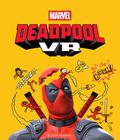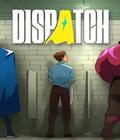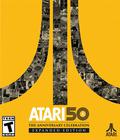
Genre: First-Person Shooter
Publisher: EA Games
Developer: Valve Software
Release Date: October 10, 2007
 The Orange Box is the mutant child of groundbreaking game developer Valve and their powerhouse distribution partner, Electronic Arts. This is the unnatural progeny of a bizarre, disfigured chess club president and the captain of the varsity football team. The baby has three heads and an assortment of mismatched appendages, but the thing is so inhumanly hideous that we may perceive it as an alien beauty.
The Orange Box is the mutant child of groundbreaking game developer Valve and their powerhouse distribution partner, Electronic Arts. This is the unnatural progeny of a bizarre, disfigured chess club president and the captain of the varsity football team. The baby has three heads and an assortment of mismatched appendages, but the thing is so inhumanly hideous that we may perceive it as an alien beauty.
The Orange Box is made of PC shooter Half-Life 2 (a version of the game existed for the original Xbox but we don't talk about that anymore); Half-Life 2: Episode One, also previously released for PC; Half-Life 2: Episode Two, new to both PCs and HD consoles; and finally Portal and Team Fortress 2, likewise new to PCs and consoles — all on one disc in a single package.
Long-delayed to the point of rampant gamer cynicism, a sequel of sorts for the popular modification to the venerable game Quake, Team Fortress 2 is the obvious mismatch here, having nothing save its Half-Life engine precursor in common with the other games and expansions. Portal is loosely related to the Half-Life universe, as portals, although not so much the type of portals in Portal, figure prominently in the Half-Life narrative spanning two full games and two standalone expansions.
Faced with reviewing this monstrosity of old, new, dismembered and reattached limbs one chases a novel, synergistic paradigm for criticism of the separate bits as a whole. But Valve saw fit to jumble all of this disparate video gaming in a package devoid of commonality between all components. Who am I to question Valve's wisdom? I'll break it down into pieces then, and briefly slap it back together for a final peek. I hope I won't have any parts left over. The only real question that remains is where to begin, and of course, the best place is the beginning.

Half-Life 2 is the critically acclaimed sequel to game critics' darling, Half-Life. It forever changed what developers could do with a first-person shooter, permanently altering the gaming audience's criteria for a good shooter. No longer was a tricked-out rocket launcher enough. But as George Lucas has explained when asked why he took so long between making the first three films in his "Star Wars" epic and producing, well, the second first three films, the available technology hadn't reached the point where he could fully realize his vision. So went Half-Life.
Whereas Half-Life laid the groundwork for a plot-centric, narrative-based shooter, the technology underlying Half-Life 2 made it all look real, or real enough. Half-Life struggled to achieve immersive gameplay from beneath nascent 3D graphics technology while Half-Life 2 leveraged technological advances of the intervening six years, straightaway immersing. Rather than propel narrative through pre-rendered cut scenes, Half-Life 2 plots unfold within the game, all around you, whether you pay close attention to the game's characters or instead wander about staring at blinking control panels. The narrative remains linear and you are restricted from progressing until after a bit of revelation, but you don't feel so much duped into plot progression as you may in cut scenes. It's a groundbreaking game design but a double-edged sword: In cut scenes, you're stuck but you can often skip them, while watching narrative elements with more or less complete mobility, you may become antsy to move on, yet you're not allowed. The trick here is to keep the narrative elements very brief and well separated by action sequences, a goal which Half-Life 2 sometimes fails.
Half-Life 2 is also well known for interactive environments — far from fully interactive, but you can pick up and move around many objects, even useless items, and interact with characters, even if they relate nothing you must learn; linearity is maintained with fewer restrictions on player behavior. Again, this signature element is two-sided: The player may feel compelled to touch everything and talk with everyone despite the futility of it, lest he miss something. This can become frustrating, like an acquired obsessive-compulsive disorder enforced by gameplay mechanics.
Ultimately, as a faithful sequel to a 1990s PC shooter, the Half-Life 2 plot is trite and uninspired — the dialogue that you'd expect a gaggle of coding and level-design sharpies would favor — but at least it had a plot. At least it tried to enhance the shooter experience beyond merely running, gunning and dying. And to that, to Valve's star-reaching, the latter-day slew of better plotted and scripted PC and console shooters owe almost everything.
In its Xbox 360 incarnation, Half-Life 2 returns in graphical glory. Walk right up against a wall and some textures pixelate, but there's so much to do and see in the game that if you spend your time gazing at walls, you're missing everything. Surround sound is expertly executed to great effect, a real boon to a game of this type, with scenes where you'll walk around an environment flipping switches or collecting items while two or more characters standing on different marks speak. Games like Half-Life 2 are why full multichannel sound belongs in contemporary consoles.
Ultimately, The Orange Box version of Half-Life 2 suffers from environments designed for the PC's more precise mouse and keyboard control. Narrow walkways are too narrow, and slim margins between successful ledge navigation and certain death too often result in the latter. Many environments used as settings for Half-Life 2's trademark object-rearranging puzzles — mostly used for progression in levels onto apparently inaccessible areas — are too large, with the objects you'll need placed too far apart to be seen as evident puzzle solutions within a reasonable amount of time. When you do figure it out — you will, as the game can be frustrating but not impossible — you spend too much time jogging back and forth carrying the necessary pieces for your Rube Goldberg contraptions.
Half-Life 2 is best played pacing yourself, especially if you're accustomed to today's more concise, abbreviated console shooter campaigns. This game can't be rushed because it indeed can't be rushed. The title is long and involved and is better enjoyed over time. It's flawed by contemporary standards, yet still well worth the experience, as contemporary standards wouldn't be so high today without it.
Score: 8.5/10

Released for the PC about two years after the full sequel title, Episode One, while ramping up a new narrative, is merely more Half-Life 2. It was not crafted with console shooter design in mind, it suffers from the same control issues and it lacks the precise refinements we expect in top-tier console titles today. There's not much more can be said about a title designed for an existing, avid Half-Life 2 audience; it is rightfully a faithful appendix to a commercially and critically successful game.
Score: 8.5/10

Episode Two is a different animal. While it retains Half-Life 2's strengths and overall theme, Valve's design methodology has evolved to stand right along today's finest plot-driven shooters. The slower narrative scenes are better balanced with adrenaline-pumping action sequences; the player doesn't feel he's spent an inordinate amount of time in transit while excitement is meted out in unsatisfactorily small portions.
Whether or not the control mechanism was specifically designed with a console release in mind, it was certainly designed with the notion a console release was possible. Walkways, ledges and narrow natural bridges spanning bottomless pits in this episode are wider and far better suited to comfortable navigation with console controllers.
In comparison with today's best titles in the genre, Half-Life 2 feels mostly unedited, but Episode 2 obviously makes ample use of the cutting room floor. The plotting is better paced and more expertly crafted. Character dialogue is clearly superior. Half-Life 2 often attempts subtle wit through its characters' lines, but Episode 2 actually pulls it off. Environments, especially those containing puzzles elements, are more confined, making puzzle solutions more obvious, more purely about logic and ingenuity than running back and forth over great distances.
Episode 2 establishes a clear path for further series installments without abandoning established fans. Best of all, it's a lot of fun in the playing, at spots challenging but only to the point of motivation, not the brink of true aggravation.
Score: 9.4/10

Team Fortress has a long, storied past from which you could compose a sizable book, but you're far better off playing this sequel than reading a history of the subject. Team Fortress 2 retains the multiplayer-only, class-based, team combat of the original game, as well as the game modes and, nostalgically, some of the maps by name but not copied layout.
There are nine player classes, as usual with their own peculiar strengths and weaknesses, but, atypically, a properly fought 16-player Team Fortress 2 match requires, if not all of them, most of them. Online teammates are indeed drawn to a variety of classes, which is amazing for a console class-based title in which players almost always choose a very few favorite classes and stick with them to the detriment of the team and the potential of the whole game. As some classes are weaker, some stronger, some faster, some slower, some hidden and some obvious, teamwork is absolutely key, more so than any glorified, ostensibly realistic team-based military shooter I've ever played.
It's already November so I'm not taking much of a risk here, but I'll call Team Fortress 2 and Sony's Warhawk the best multiplayer console titles of 2007. They can share the limelight because they are distinctly different games.
Ultimately, in the realm of military multiplayer shooters, the titanic Call of Duty 4 may prove better designed than Team Fortress 2, but I'll gladly bet that title will have less overall success cajoling a random bunch of online gamers into playing along with its intentions. Part of this is due to Team Fortress 2's visuals, billed as "distinctive" by the developers. That adjective is pure marketing hyperbole. "Distinctive" in what sense? It looks like — well looks like, beautifully rendered and art-directed — any number of blockbuster computer-graphics animated films of recent years, a style readily adopted by other game genres, especially platformers. It's surely unique to the genre of multiplayer military shooters, but it's hardly distinctive. However, the visual style is important to the game's success; it's too ridiculous to take seriously, and if you don't take it seriously, who cares if you win or lose? Therefore, should they lose, players very rarely become enraged, hurling invective at their opponents and teammates. What do ranks and leaderboards matter in this realm of absurdity?
Team Fortress 2 is unabashedly a game, with no pretensions to the status of pseudo-sport. I'll be heartbroken when I see organized, ladder-based Team Fortress 2 tournaments crop up; I'm sure they will, as some gamers can't resist any opportunity to see their names spelled out in bright lights. But this title is everything about video games that enamored young children with the pastime, although it well survives the expectations of a maturing audience.
The title is near-perfect, with two caveats: Matches are hosted in non-dedicated fashion on players' Xbox 360s, always a dicey business, and you'll serve everyone in the Team Fortress community if, before hosting games, you assure you've a stable connection with a clean, consistent upstream data rate. The game modes and maps are also tied together; for example you can only play a Capture the Flag variant on "2fort," Attack and Defend is reserved for other maps and so on. This latter bump is more a design decision than corner-cutting, as some maps are better suited to particular game types than others, but it does limit the overall combination of match options.
Team Fortress Classic isn't really classic, but Team Fortress 2 is an instant classic.
Score: 9.7/10

Portal. I could stop there. Laziness lounging on my left shoulder says, You have to play it to get it so there's no point in bothering to write more. Diligence standing at attention on the opposite side commands, Tear it down into component pieces and describe it in explicit detail until they fully understand it, sight unseen. In this case, Diligence is as always honorable but Laziness is right. Portal, described in any number of words, makes little sense and certainly has no allure. Even at best, should I hit the target dead center, my explanation of Portal won't make anyone want to play it, and should I miss, I could put you far off it. I certainly could say it's like a Rubik's Cube, but I'd have to tell you there are no squares marked with primary colors, no sides, no cube, either — what can you make of that?
It's fair to say Portal is far simpler than the graphical glitz and sly bon mots spoken over the "testing center" intercom that Valve has grafted on top of it. Indeed anyone who has had administered a formal, recognized intelligence test complete with spatial reason examination will discover immediate familiarity with the basic design. That sounds like fun, doesn't it? An IQ test with included spatial reasoning problems. Yawn. Come back and yawn at me after you've been up all night a week straight with Portal. It's the best console puzzle game yet created; you'll only dislike it if you dislike puzzles, and in such case it was, reasonably, never meant for you.
Score: 9.9/10
 Here's the part where I promised reassembling all these disparate elements; instead, I'll just tear it apart all over again. Half-Life 2 is already an inarguable classic of shooter design — once a great game, still a good game. Likewise, Episode One is a nice extra yet advances little. Episode Two, however, proves Valve can create games to suit console controls and also evolve their signature game design to fit contemporary standards. Team Fortress 2 is a stellar team multiplayer game, a new high-water mark in the genre. Portal should send all other puzzle game designers back to their drawing boards, and not just in video game puzzles, either. If I were, collectively, Valve, the thing I'd have done differently, I believe done better, in cobbling together a semi-related collection of games: I'd have axed Half-Life 2 and Episode One from the deal altogether — blasphemy! — and instead I'd have delivered a smaller but more purely sublime package. Each component of the package has moderate to minor flaws, but as a whole of historical significance and truly unique, entirely innovative contemporary game design, The Orange Box is pretty damn close to perfect, barring the rare, almost accidental miracle title.
Here's the part where I promised reassembling all these disparate elements; instead, I'll just tear it apart all over again. Half-Life 2 is already an inarguable classic of shooter design — once a great game, still a good game. Likewise, Episode One is a nice extra yet advances little. Episode Two, however, proves Valve can create games to suit console controls and also evolve their signature game design to fit contemporary standards. Team Fortress 2 is a stellar team multiplayer game, a new high-water mark in the genre. Portal should send all other puzzle game designers back to their drawing boards, and not just in video game puzzles, either. If I were, collectively, Valve, the thing I'd have done differently, I believe done better, in cobbling together a semi-related collection of games: I'd have axed Half-Life 2 and Episode One from the deal altogether — blasphemy! — and instead I'd have delivered a smaller but more purely sublime package. Each component of the package has moderate to minor flaws, but as a whole of historical significance and truly unique, entirely innovative contemporary game design, The Orange Box is pretty damn close to perfect, barring the rare, almost accidental miracle title.
Overall Score: 9.7/10























































